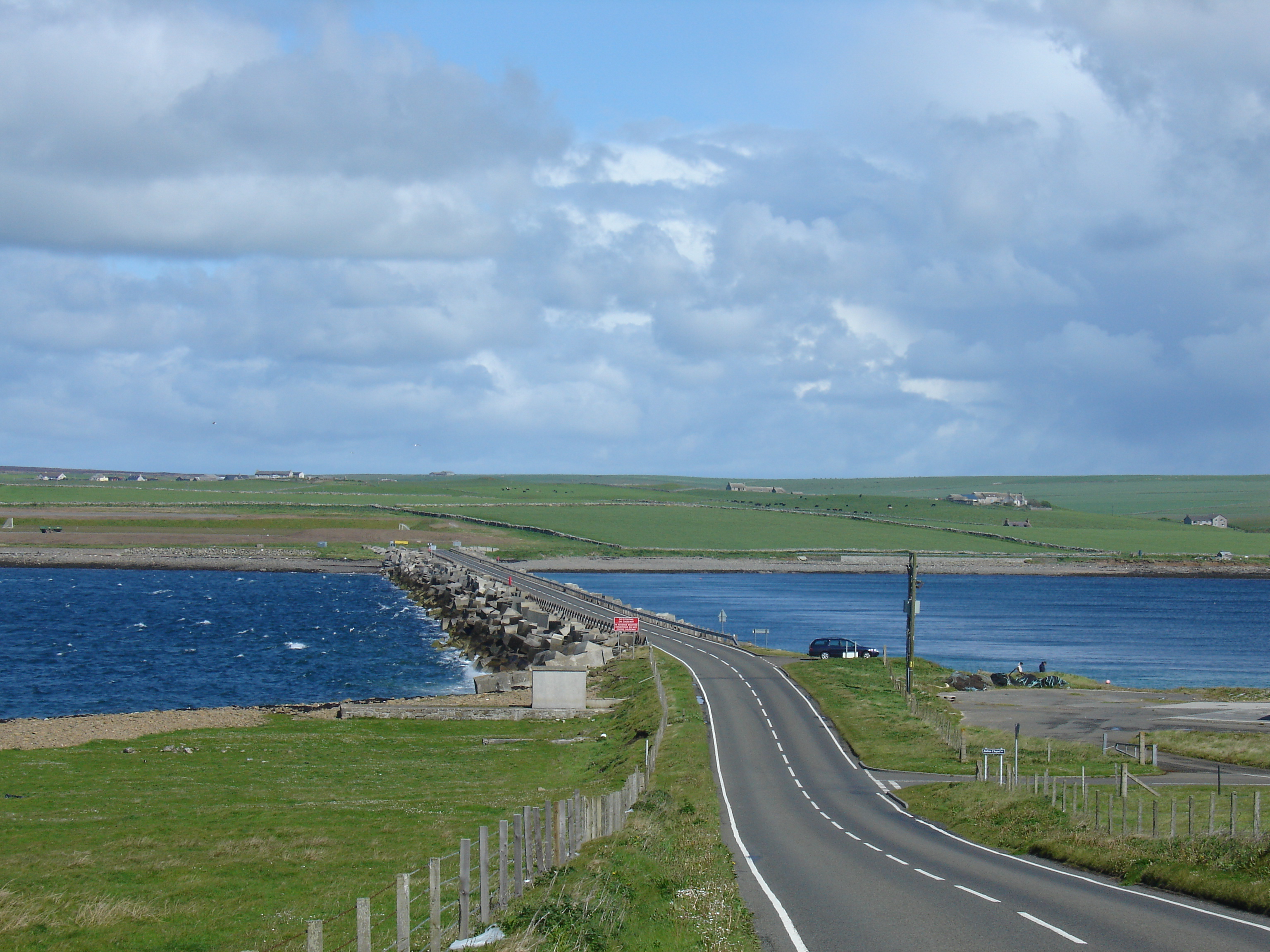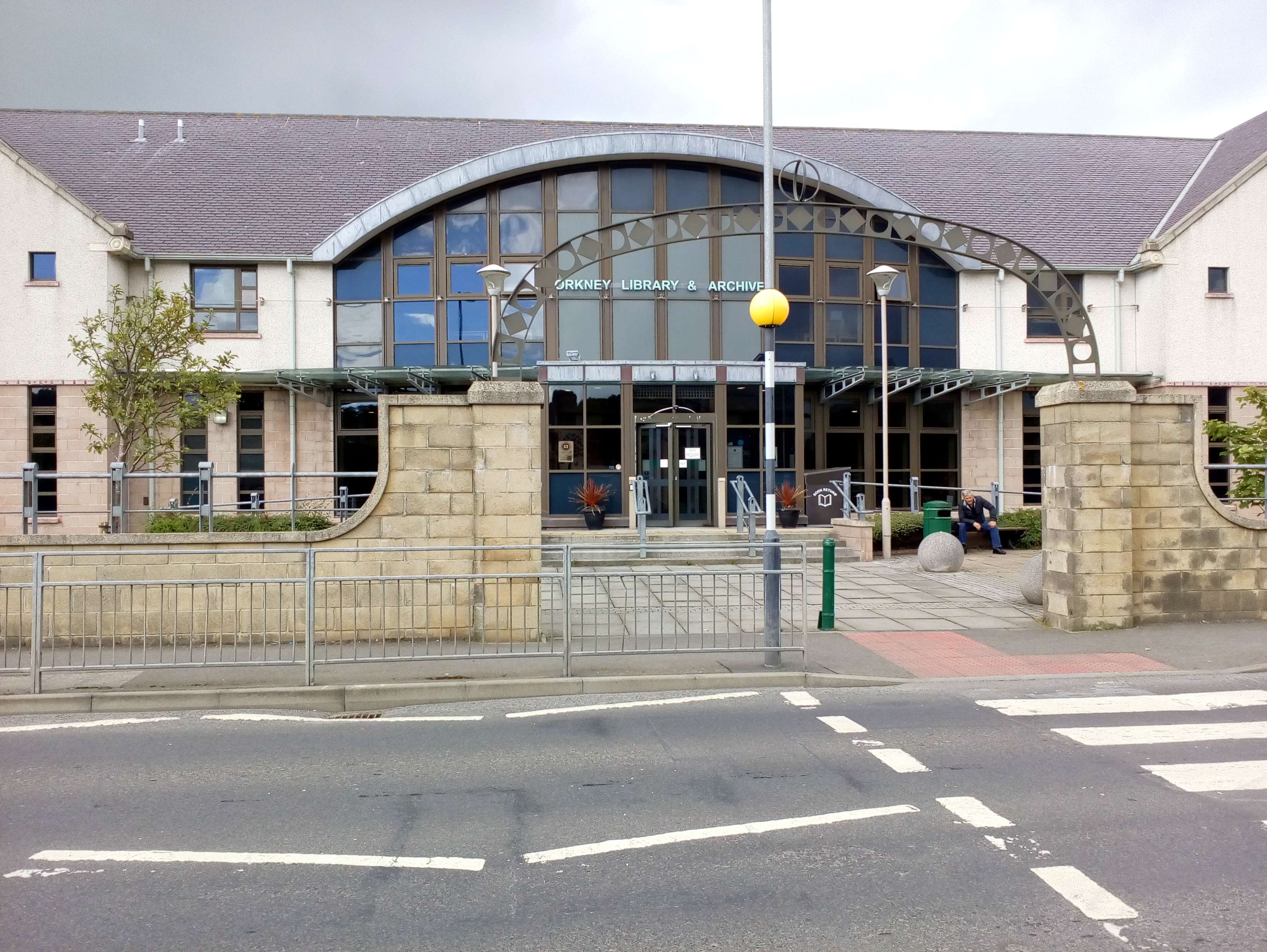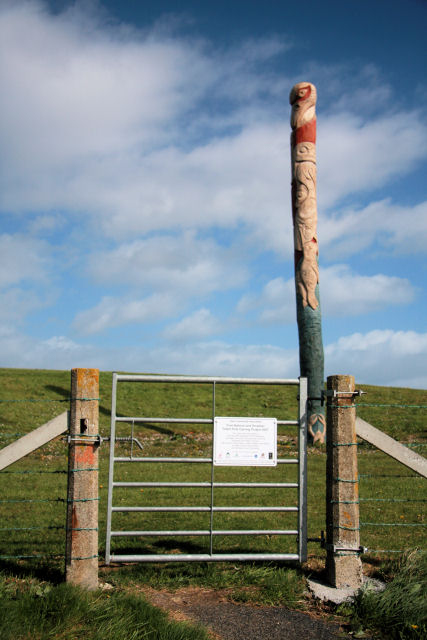|
A961 Road
The A961 is a single-carriageway road on the eastern side of Scapa Flow in the Orkney Islands, connecting the town of Kirkwall on the Orkney Mainland to Burwick at the southern end of South Ronaldsay. The road links four islands to the mainland, crossing four causeways known collectively as the Churchill Barriers, which were built during World War II as naval defences to protect the natural harbour of Scapa Flow after a successful attack by a German U-boat. Proceeding southwards from Kirkwall, the road travels south to St Mary's, from where it crosses Kirk Sound on the first Churchill Barrier to the island of Lamb Holm, site of the Italian Chapel built by the Italian prisoners of war who built the barriers. The second barrier carries the road to the island of Glimps Holm, from where the third barrier connects to the larger island of Burray Burray () is one of the Orkney Islands in Scotland. It lies to the east of Scapa Flow and is one of a chain of islands linked ... [...More Info...] [...Related Items...] OR: [Wikipedia] [Google] [Baidu] |
Kirkwall
Kirkwall ( sco, Kirkwaa, gd, Bàgh na h-Eaglaise, nrn, Kirkavå) is the largest town in Orkney, an archipelago to the north of mainland Scotland. The name Kirkwall comes from the Norse name (''Church Bay''), which later changed to ''Kirkvoe'', ''Kirkwaa'' and ''Kirkwall''. Kirkwall was formerly the site of an ancient Norse town founded approximately 1000 years ago. Today, it is a transport hub with ferries to many locations. History The town was first mentioned in in the year 1046, when it was recorded as the residence of , the Earl of Orkney, who was killed by his uncle Thorfinn the Mighty. In 1486, King James III of Scotland elevated Kirkwall to the status of a royal burgh. On the western edge of the town, surrounded by Hatston Industrial Estate, there is a prehistoric monument, known as the "Grain Earth House" (see Historic Scotland). It is a short, low, stone-walled passage, deep underground, leading to a small pillared chamber. This kind of earth house (or "souterrai ... [...More Info...] [...Related Items...] OR: [Wikipedia] [Google] [Baidu] |
U-boat
U-boats were naval submarines operated by Germany, particularly in the First and Second World Wars. Although at times they were efficient fleet weapons against enemy naval warships, they were most effectively used in an economic warfare role (commerce raiding) and enforcing a naval blockade against enemy shipping. The primary targets of the U-boat campaigns in both wars were the merchant convoys bringing supplies from Canada and other parts of the British Empire, and from the United States, to the United Kingdom and (during the Second World War) to the Soviet Union and the Allied territories in the Mediterranean. German submarines also destroyed Brazilian merchant ships during World War II, causing Brazil to declare war on both Germany and Italy on 22 August 1942. The term is an anglicised version of the German word ''U-Boot'' , a shortening of ''Unterseeboot'' ('under-sea-boat'), though the German term refers to any submarine. Austro-Hungarian Navy submarines were also kno ... [...More Info...] [...Related Items...] OR: [Wikipedia] [Google] [Baidu] |
St Margaret's Hope
St Margaret's Hope is a village in the Orkney Islands, off the north coast of Scotland. It is known locally as "The Hope" or "The Hup". With a population of about 550, it is Orkney's third largest settlement after Kirkwall and Stromness. St Margaret's Hope is the main settlement of the island of South Ronaldsay. Situated off Water Sound at the head of a calm bay on the island's northern coast, it is connected to the Orkney Mainland by the A961 road running across the Churchill Barriers. St Margaret's Hope is believed to have been named after either Saint Margaret of Scotland (c.1045-1093), the wife of Malcolm III, or Margaret, Maid of Norway, who died in Orkney and possibly in this location in 1290. The village has a primary school, a small blacksmith's museum, a few shops and a cafe, a pub and a wine bar. Pentland Ferries run a reliable service from the pier in the bay to Gills Bay on the Scottish mainland. It is also known for its annual Boys' Ploughing Match A pl ... [...More Info...] [...Related Items...] OR: [Wikipedia] [Google] [Baidu] |
Glimps Holm
Glimps Holm or Glims Holm ( non, Glums Holm) is a small uninhabited islet in Orkney, Scotland. Geography Glimps Holm lies in Holm Sound, one of the eastern entrances to Scapa Flow, between Mainland, Orkney and the island of Burray. The Churchill Barriers link South Ronaldsay to the Orkney Mainland. Glimps Holm is connected to Lamb Holm, to the northeast, by Barrier number 2, and to Burray by Barrier number 3. History Scapa Flow had many entrances, making it difficult to protect the anchorages in this natural harbour. Blockships had been sunk to close the narrow passages, but these proved inadequate. The Churchill Barriers were built during World War II to block the eastern entrances. Much of the labour for the causeways was provided by over 1300 Italian prisoners of war, captured in North Africa and stationed in Camp 60 on Lamb Holm Lamb Holm is a small uninhabited island in Orkney, Scotland. The Italian Chapel, constructed during the Second World War, is the island's ... [...More Info...] [...Related Items...] OR: [Wikipedia] [Google] [Baidu] |
Italian Chapel
The Italian Chapel is a highly ornate Catholic chapel on Lamb Holm in the Orkney Islands. It was built during World War II by Italian prisoners of war, who were housed on the previously uninhabited island while they constructed the Churchill Barriers to the east of Scapa Flow. Only the concrete foundations of the other buildings of the prisoner-of-war camp survive. The chapel was not completed until after the end of the war, and was restored in the 1960s and again in the 1990s. It is a popular tourist attraction, and a category A listed building. It is in the Roman Catholic Parish of Our Lady & St Joseph in Orkney, part of the Roman Catholic Diocese of Aberdeen. Mass is held in the chapel on the first Sunday of the summer months (April–September). Construction 550 Italian prisoners of war, captured in North Africa during World War II, were brought to Orkney in 1942. They worked on the construction of the Churchill Barriers, four causeways created to block access to Scapa F ... [...More Info...] [...Related Items...] OR: [Wikipedia] [Google] [Baidu] |
Lamb Holm
Lamb Holm is a small uninhabited island in Orkney, Scotland. The Italian Chapel, constructed during the Second World War, is the island's main attraction. Lamb Holm is classified by the National Records of Scotland as an uninhabited island that "had no usual residents at the time of either the 2001 or 2011 censuses." Geography Lamb Holm lies in Holm Sound, one of the eastern entrances to Scapa Flow, between Mainland, Orkney and the island of Burray, It is in area. The Churchill Barriers carry the road from South Ronaldsay to Mainland, Orkney. Lamb Holm is connected to Glimps Holm, to the southwest, by Barrier number 2, and to Mainland by Barrier number 1. The quarry used to build the Churchill Barriers has now been flooded and converted into a fish farm. On the northwest of the island, on the shore of St Mary's Bay, are the remains of a prehistoric settlement which have been designated as a scheduled monument. There is a Bronze age Barrow mound on the island named as "Lau ... [...More Info...] [...Related Items...] OR: [Wikipedia] [Google] [Baidu] |
Kirk Sound
Kirk is a Scottish and former Northern English word meaning "church". It is often used specifically of the Church of Scotland. Many place names and personal names are also derived from it. Basic meaning and etymology As a common noun, ''kirk'' (meaning 'church') is found in Scots, Scottish English, Ulster-Scots and some English dialects, attested as a noun from the 14th century onwards, but as an element in placenames much earlier. Both words, ''kirk'' and ''church'', derive from the Koine Greek κυριακόν (δωμα) (kyriakon (dōma)) meaning ''Lord's (house)'', which was borrowed into the Germanic languages in late antiquity, possibly in the course of the Gothic missions. (Only a connection with the idiosyncrasies of Gothic explains how a Greek neuter noun became a Germanic feminine). Whereas ''church'' displays Old English palatalisation, ''kirk'' is a loanword from Old Norse and thus retains the original mainland Germanic consonants. Compare cognates: Icelandic & ... [...More Info...] [...Related Items...] OR: [Wikipedia] [Google] [Baidu] |
St Mary's, Orkney
St Mary's (also known as St. Mary's Holm) is a small village in the parish of Holm on Mainland, Orkney, Scotland. It was originally a fishing port. Orkney F.C., the island group's main football club, plays its home games at The Rockworks Community Park, St. Mary's. Close to the ground, immediately to the north of the northernmost Churchill barrier, is a totem pole, erected as part of a community project in 2007 by local carvers and members of the Squamish First Nation Indigenous peoples are culturally distinct ethnic groups whose members are directly descended from the earliest known inhabitants of a particular geographic region and, to some extent, maintain the language and culture of those original people ... people of western Canada.Bell, B.,Orkney Walks: Between Two Totem Poles" ''The Orkney News'', 19 February 2018. Retrieved 11 April 2022. References External links Scapaflow.co - St Mary's, HolmArchived frothe originalon 2016-06-11. Retrieved 2018-06-20. Vi ... [...More Info...] [...Related Items...] OR: [Wikipedia] [Google] [Baidu] |
Churchill Barrier 1
Sir Winston Leonard Spencer Churchill (30 November 187424 January 1965) was a British statesman, soldier, and writer who served as Prime Minister of the United Kingdom twice, from 1940 to 1945 Winston Churchill in the Second World War, during the Second World War, and again from 1951 to 1955. Apart from two years between 1922 and 1924, he was a Member of Parliament (United Kingdom), Member of Parliament (MP) from 1900 to 1964 and represented a total of five UK Parliament constituency, constituencies. Ideologically an Economic liberalism, economic liberal and British Empire, imperialist, he was for most of his career a member of the Conservative Party (UK), Conservative Party, which he led from 1940 to 1955. He was a member of the Liberal Party (UK), Liberal Party from 1904 to 1924. Of mixed English and American parentage, Churchill was born in Oxfordshire to Spencer family, a wealthy, aristocratic family. He joined the British Army in 1895 and saw action in British Raj, Br ... [...More Info...] [...Related Items...] OR: [Wikipedia] [Google] [Baidu] |
World War II
World War II or the Second World War, often abbreviated as WWII or WW2, was a world war that lasted from 1939 to 1945. It involved the vast majority of the world's countries—including all of the great powers—forming two opposing military alliances: the Allies and the Axis powers. World War II was a total war that directly involved more than 100 million personnel from more than 30 countries. The major participants in the war threw their entire economic, industrial, and scientific capabilities behind the war effort, blurring the distinction between civilian and military resources. Aircraft played a major role in the conflict, enabling the strategic bombing of population centres and deploying the only two nuclear weapons ever used in war. World War II was by far the deadliest conflict in human history; it resulted in 70 to 85 million fatalities, mostly among civilians. Tens of millions died due to genocides (including the Holocaust), starvation, ma ... [...More Info...] [...Related Items...] OR: [Wikipedia] [Google] [Baidu] |
Burwick, Orkney
Burwick () is a small harbour on the island of South Ronaldsay in the Orkney Islands, Scotland. It is the closest Orkney harbour to the Scottish mainland and is the terminus of a passenger ferry which operates in the summer to John o' Groats in Caithness. The name was first recorded in about 1225 as "Bardvik", derived from the Old Norse ''bar vík'', meaning "bay of the extremity", for its position near the southernmost point of the island. The remains of the Castle of Burwick, a defended Iron Age The Iron Age is the final epoch of the three-age division of the prehistory and protohistory of humanity. It was preceded by the Stone Age (Paleolithic, Mesolithic, Neolithic) and the Bronze Age (Chalcolithic). The concept has been mostly appl ... fort and probable secondary monastic settlement, occupy the promontory west of the harbour. References External links Ports and Harbours of the UK - Burwick, South Ronaldsay [...More Info...] [...Related Items...] OR: [Wikipedia] [Google] [Baidu] |
Churchill Barriers
The Churchill Barriers are four causeways in the Orkney islands with a total length of . They link the Orkney Mainland in the north to the island of South Ronaldsay via Burray and the two smaller islands of Lamb Holm and Glimps Holm. The barriers were built between May 1940 and September 1944, primarily as naval defences to protect the anchorage at Scapa Flow, but since 12 May 1945, serve as road links between the islands. The two southern barriers, Glimps Holm to Burray and Burray to South Ronaldsay, are Category A listed. History On 14 October 1939, the Royal Navy battleship HMS ''Royal Oak'' was sunk at her moorings within the natural harbour of Scapa Flow, by the under the command of Günther Prien. ''U-47'' had entered Scapa Flow through Holm Sound, one of several eastern entrances to Scapa Flow. The eastern passages were protected by measures including sunken block ships, booms and anti-submarine nets, but ''U-47'' entered at night at high tide by navigating be ... [...More Info...] [...Related Items...] OR: [Wikipedia] [Google] [Baidu] |








